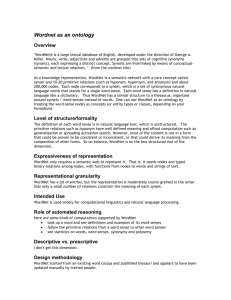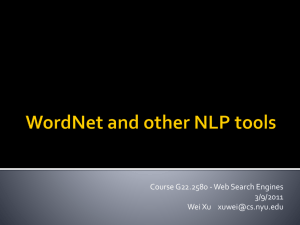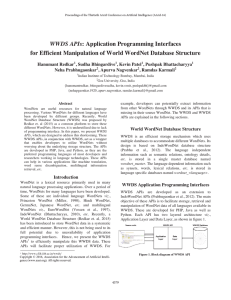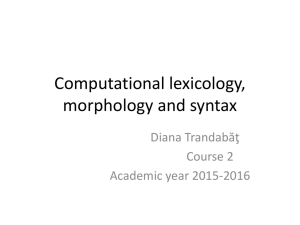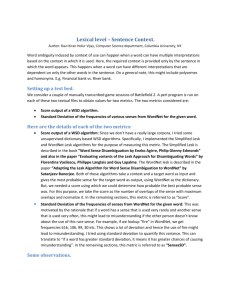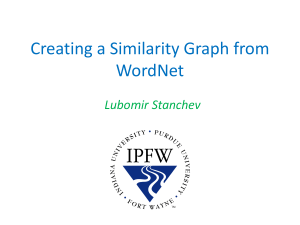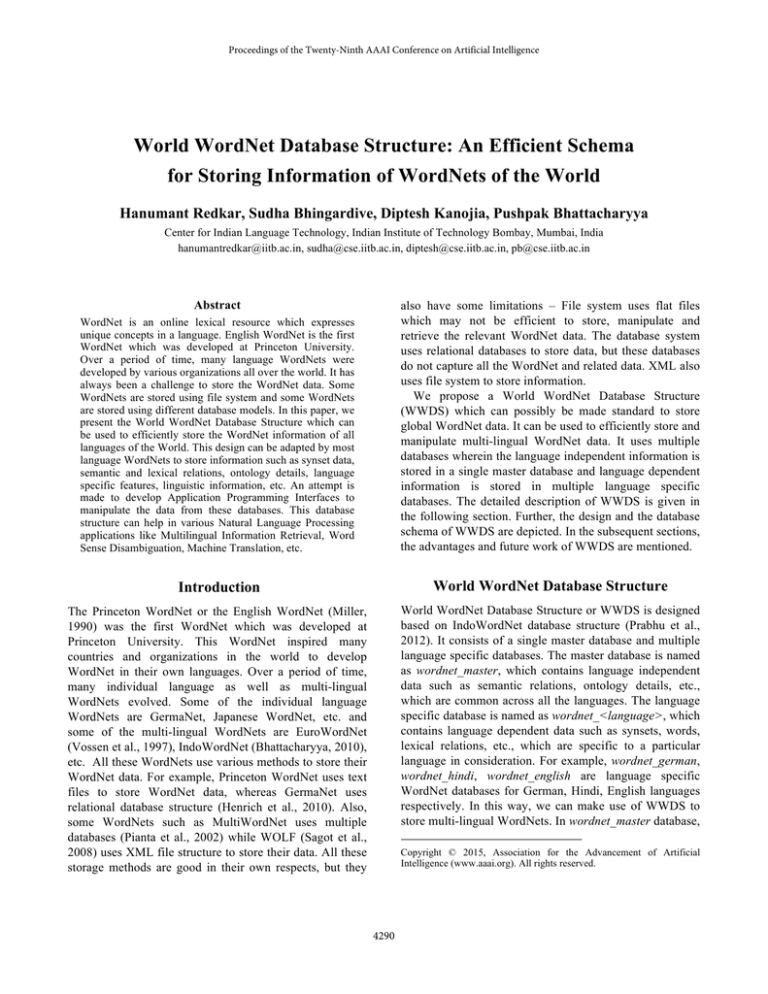
Proceedings of the Twenty-Ninth AAAI Conference on Artificial Intelligence
World WordNet Database Structure: An Efficient Schema
for Storing Information of WordNets of the World
Hanumant Redkar, Sudha Bhingardive, Diptesh Kanojia, Pushpak Bhattacharyya
Center for Indian Language Technology, Indian Institute of Technology Bombay, Mumbai, India
hanumantredkar@iitb.ac.in, sudha@cse.iitb.ac.in, diptesh@cse.iitb.ac.in, pb@cse.iitb.ac.in
Abstract
WordNet is an online lexical resource which expresses
unique concepts in a language. English WordNet is the first
WordNet which was developed at Princeton University.
Over a period of time, many language WordNets were
developed by various organizations all over the world. It has
always been a challenge to store the WordNet data. Some
WordNets are stored using file system and some WordNets
are stored using different database models. In this paper, we
present the World WordNet Database Structure which can
be used to efficiently store the WordNet information of all
languages of the World. This design can be adapted by most
language WordNets to store information such as synset data,
semantic and lexical relations, ontology details, language
specific features, linguistic information, etc. An attempt is
made to develop Application Programming Interfaces to
manipulate the data from these databases. This database
structure can help in various Natural Language Processing
applications like Multilingual Information Retrieval, Word
Sense Disambiguation, Machine Translation, etc.
also have some limitations – File system uses flat files
which may not be efficient to store, manipulate and
retrieve the relevant WordNet data. The database system
uses relational databases to store data, but these databases
do not capture all the WordNet and related data. XML also
uses file system to store information.
We propose a World WordNet Database Structure
(WWDS) which can possibly be made standard to store
global WordNet data. It can be used to efficiently store and
manipulate multi-lingual WordNet data. It uses multiple
databases wherein the language independent information is
stored in a single master database and language dependent
information is stored in multiple language specific
databases. The detailed description of WWDS is given in
the following section. Further, the design and the database
schema of WWDS are depicted. In the subsequent sections,
the advantages and future work of WWDS are mentioned.
Introduction
World WordNet Database Structure
The Princeton WordNet or the English WordNet (Miller,
1990) was the first WordNet which was developed at
Princeton University. This WordNet inspired many
countries and organizations in the world to develop
WordNet in their own languages. Over a period of time,
many individual language as well as multi-lingual
WordNets evolved. Some of the individual language
WordNets are GermaNet, Japanese WordNet, etc. and
some of the multi-lingual WordNets are EuroWordNet
(Vossen et al., 1997), IndoWordNet (Bhattacharyya, 2010),
etc. All these WordNets use various methods to store their
WordNet data. For example, Princeton WordNet uses text
files to store WordNet data, whereas GermaNet uses
relational database structure (Henrich et al., 2010). Also,
some WordNets such as MultiWordNet uses multiple
databases (Pianta et al., 2002) while WOLF (Sagot et al.,
2008) uses XML file structure to store their data. All these
storage methods are good in their own respects, but they
World WordNet Database Structure or WWDS is designed
based on IndoWordNet database structure (Prabhu et al.,
2012). It consists of a single master database and multiple
language specific databases. The master database is named
as wordnet_master, which contains language independent
data such as semantic relations, ontology details, etc.,
which are common across all the languages. The language
specific database is named as wordnet_<language>, which
contains language dependent data such as synsets, words,
lexical relations, etc., which are specific to a particular
language in consideration. For example, wordnet_german,
wordnet_hindi, wordnet_english are language specific
WordNet databases for German, Hindi, English languages
respectively. In this way, we can make use of WWDS to
store multi-lingual WordNets. In wordnet_master database,
Copyright © 2015, Association for the Advancement of Artificial
Intelligence (www.aaai.org). All rights reserved.
4290
the table wn_master_inter_lingual_synset has inter-lingual
synset id (il_synset_id) which links synset ids of all the
language databases. This gives provision to access crosslingual synset data. Application Programming Interfaces
(APIs) for WWDS are developed based on IndoWordNet
APIs (Prabhugaonkar et al., 2012). Also, an attempt has
been made to develop scripts for importing data to WWDS.
Design of the WWDS
The basic design of WWDS has been borrowed from
IndoWordNet database schema with further improvement
to its database structure. This structure can possibly be
adapted to most of the WordNets of the world. Figure 1
shows the basic block diagram of WWDS.
Figure 1. Block diagram of WWDS
WWDS Database Schema
Figure 2. Database model diagram of WWDS
Figure 2 depicts the WWDS database model diagram
showing tables and their attributes. The left hand side of
the figure has tables from wordnet_<language> database
and the right hand side has tables from wordnet_master
database. Primary key attributes are underlined and foreign
keys attributes can be identified by the link between tables.
Word Sense Disambiguation, etc. APIs are built to access
and manipulate the WordNet data. In the future, we plan to
study features of individual languages and revise the
WWDS. Also, we plan to store information such as corpus,
annotated data, morphological features, etc in the WWDS.
References
Some Advantages of WWDS
One of the major advantages of WWDS is that, using interlingual synset id, one can retrieve cross-lingual synset
information of most of the languages. Another advantage is
that, it is a centralized database which can be used in
bigger applications like Cross Lingual Information
Retrieval, Word Sense Disambiguation, Data Mining, etc.
Bhattacharyya, P. 2010. IndoWordNet. Proc. of LREC-10, Malta.
Henrich, V., & Hinrichs, E. W. 2010. GernEdiT-The GermaNet
Editing Tool. In ACL (System Demo), Malta. (pp. 19-24).
Miller, George A., R., Fellbaum, C., Gross, D., & Miller, K. J.
1990. Introduction to wordnet: An on-line lexical database.
International journal of lexicography, OUP. (pp. 3.4: 235-244).
Pianta, E., Bentivogli, L., & Girardi, C. 2002. Developing an
aligned multilingual database. In Proc. 1st GWC, Mysore, India.
Prabhu, V., Desai, S., Redkar, H., Prabhugaonkar, N., Nagvenkar,
A., & Karmali, R. 2012. An Efficient Database Design for
IndoWordNet Development Using Hybrid Approach. COLING
2012, Mumbai, India. (pp. 229).
Prabhugaonkar, N., Nagvenkar, A., & Karmali, Ramdas N. 2012.
IndoWordNet Application Programming Interfaces. COLING
2012, Mumbai, India. (pp. 237 - 244).
Sagot, B., & Fišer, D. 2008. Building a free French wordnet from
multilingual resources. In OntoLex 2008, Morocco.
Vossen, P. 1997. EuroWordNet: A multilingual database for
information retrieval. DELOS, Zurich. (pp. 5-7).
Conclusion and Future Work
Multiple WordNets use various data storage methods such
as flat files, databases, etc. In this paper, we have presented
an efficient and normalized database schema viz. WWDS
for storing, manipulating and retrieving multi-lingual
WordNet information. WWDS is an attempt to link most of
the WordNets together by providing a centralized storage
structure. One can easily adapt this structure to store their
WordNet data. Some of the applications of WWDS could
be Cross Lingual Information Retrieval, Multi-lingual
4291



